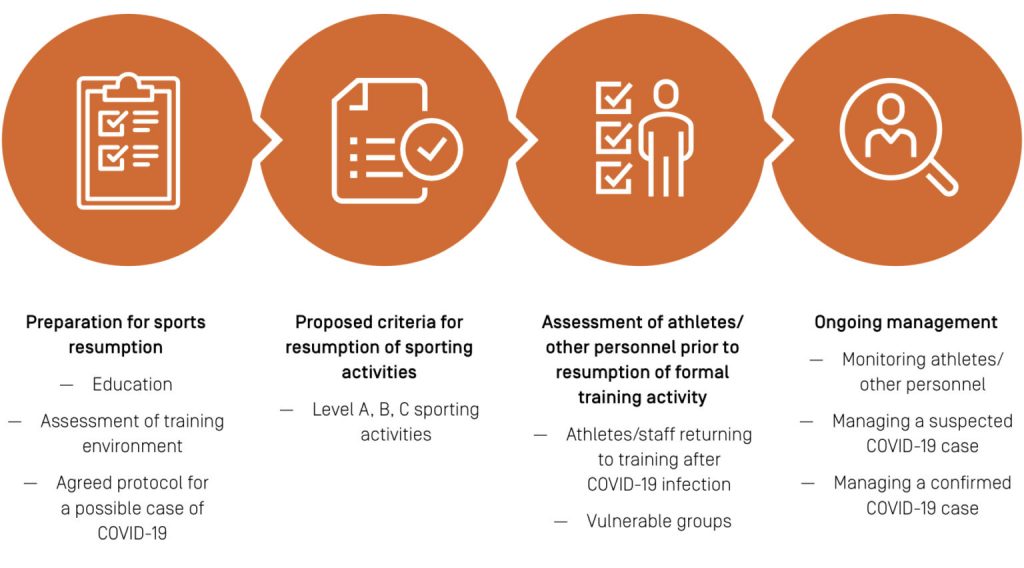Sport delivers more than just benefits to our physical health. With COVID-19 having decimated any notion of ‘normality’ within local communities, the contribution of sport to community identity is potentially more important than ever, providing a focal point for community engagement and sense of normality. With the SARS-CoV-2 virus still active in many part of the world, many wonder what community sport will look like in this COVID-19 climate, and how sporting bodies and society can navigate the resumption of sport safely? The AIS Framework provides a roadmap for ‘how’ reintroduction of sport activity can occur based on the best available evidence to enable individuals to participate in sporting activities in a safe manner.1 The overriding priority for sport is to ensure that any return to sport activity does not endanger public health.
What can you do as an athlete?
Whether you call it common sense or ‘self-leadership’, all of us as individuals have a responsibility to keep COVID-19 transmission suppressed. Good hand hygiene, respiratory hygiene and social distancing are strongly promoted by government to reduce to spread of COVID-19, and the same principles apply when returning to sport.
Some established norms such as sharing drink bottles, hugging and shaking hands can increase the risk of infection and we should all avoid these behaviours.
Improving health literacy about COVID-19 will ensure the sporting community understands how to avoid getting or spreading the infection, and will improve awareness of self-monitoring of respiratory symptoms (even if mild). It is not possible to differentiate COVID-19 from any other ‘garden variety’ viral respiratory infection based on symptoms or symptom severity.
If you have any respiratory symptoms (even if mild), you should be considered a potential case and must immediately self-isolate until COVID-19 has been excluded. Also If you have had contact with a known or suspected case of COVID-19 in the past 14 days, you must not join the training environment.
If you are returning to sport after recovering from COVID-19 you need clearance from your doctor. This is because of the multi-organ nature of the COVID-19.1 You need to make sure that you are sufficiently recovered to safely participate in exercise (specifically for players/other personnel undertaking physical roles). Also, you need to make sure that you do not pose any infection risk to the community.
What can your club do?
All community sporting organisations must ensure that the activities undertaken in training and competition are consistent with the applicable guidance from Local Public Health Authorities. Sport Australia’s Return to Sport Toolkit includes a suite of free resources to help prepare for training, competitions and programs in a safe, responsible and low risk manner.
General considerations for clubs include:
- Educating players, parents, coaches, volunteers, referees and other personnel (this can help to set expectations and promote desired behaviours prior to recommencing activities)
- Cleaning changing rooms, surfaces and objects in other relevant spaces between exercise sessions/matches with disinfectant
- Adopting a ‘get in, train and get out’ mantra to reduce physical contact. Players should prepare for exercise at home, to minimise need to congregate in change rooms/sporting facilities. Players should get dressed to train/compete at home and shower at home on completion
- Promoting and adapting recovery sessions and tactical meetings etc to take place online
- Publicly advocating social distancing measures (and practically design communal spaces accordingly) to ensure players, support personnel and spectators maintain social distancing of at least 1.5m
- Advocating avoiding unnecessary body contact such as hand shaking, high fives and group hugs
- Considering whether it is appropriate to serve food and drink at community events, as this will likely encourage spectators to come into close proximity with each other
- Providing hand-hygiene stations in high traffic areas and entry/exit point and the provision of masks etc (where this is possible)

Read full article here.
